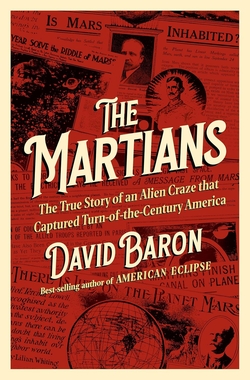Centauri Dreams
Imagining and Planning Interstellar Exploration
Rethinking Planet 9
Trans-Neptunian Objects, or TNOs, sound simple enough, the term being descriptive of objects moving beyond the orbit of Neptune, which means objects with a semimajor axis greater than 30 AU. It makes sense that such objects would be out there as remnants of planet formation, but they’re highly useful today in telling us about what the outer system consists of. Part of the reason for that is that TNOs come in a variety of types, and the motions of these objects can point to things we have yet to discover.
Thus the cottage industry in finding a ninth planet in the Solar System, with all the intrigue that provides. The current ‘Planet 9 Model’ points to a super-Earth five to ten times as massive as our planet located beyond 400 AU. It’s a topic we’ve discussed often in these pages. I can recall the feeling I had long ago when I first learned that little Pluto really didn’t explain everything we were discovering about the system beyond Neptune. It simply wasn’t big enough. That pointed to something else, but what? New planets are exciting stuff, especially when they are nearby, as the possibility of flybys and landings in a foreseeable future is real.
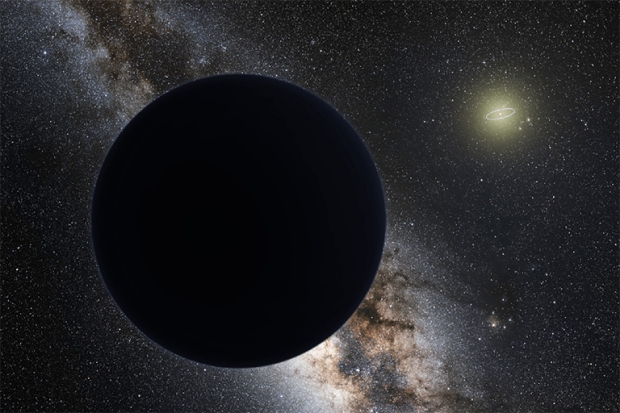
Image: An artist’s illustration of a possible ninth planet in our solar system, hovering at the edge of our solar system. Neptune’s orbit is show as a bright ring around the Sun. Credit: ESO/Tom Ruen/nagualdesign.
But a different solution for a trans-Neptunian planet is possible, as found in the paper under discussion today. Among the active researchers into the more than 1000 known TNOs and their movements are Patryk Sofia Lykawka (Kobe University) and Takashi Ito (National Astronomical Observatory of Japan), who lay out the basics about these objects in a new paper that has just appeared in The Astronomical Journal. The astronomers point out that we can use them to learn about the formation and evolution of the giant planets, including possible migrations and the makeup of the protoplanetary disk that spawned them. But it’s noteworthy that no single evolutionary model exists that would explain all known TNO orbits in a unified way.
So the paper goes to work on such a model, and while concentrating on the Kuiper Belt and objects with semimajor axes between 50 and 1500 AU, the authors pin down four populations, and thus four constraints that any successful model of the population must explain. The first of these are detached TNOs, meaning objects that are outside the gravitational influence of Neptune and thus not locked into any mean motion resonance with it. The second is a population the authors consider statistically significant, TNOs with orbital inclinations to the ecliptic above 45 degrees. This population is not predicted by existing models of early Neptune migration.
The paper is generous with details about these and the following two populations, but here I’ll just give the basics. The third group consists of TNOs considered to be on extreme orbits. Here we fall back on the useful Sedna and other objects with large values for perihelion of 60 AU or more. These demand that we find a cause for perturbations beyond the four giant planets, possibly even a rogue planet’s passing. Any model of the outer system must be able to explain the orbits of these extreme objects, an open question because interactions with a migrating Neptune do not suffice.
Finally, we have a population of TNOs that are stable in various mean motion resonances with Neptune over billions of years – the authors call these “stable resonance TNOs” – and it’s interesting to note that most of them are locked in a resonance of approximately 4 billion years, which points to their early origin. The point is that we have to be able to explain all four of these populations as we evolve a theory on what kind of objects could produce the observable result.
What a wild place the outer Solar System would have been during the period of planet formation. The authors believe it likely that several thousand dwarf planets with mass in the range of Pluto and “several tens” of sub-Earth and Earth-class planets would have formed in this era, most of them lost through gravitational scattering or collisions. We’ve been looking at trans-Neptunian planet explanations for today’s Kuiper Belt intensely for several decades, but of the various suggested possibilities, none explained the orbital structure of the Kuiper Belt to the satisfaction of Lykawka and Ito. The existing Planet 9 model here gives way to a somewhat closer, somewhat smaller world deduced from computer simulations examining the dynamical evolution of TNOs.
What the authors introduce, then, is the possibility of a super-Earth perhaps as little as 1.5 times Earth’s mass with a semimajor axis in the range of 250 to 500 AU. The closest perihelion works out to 195 au in these calculations, with an orbit that is inclined 30 degrees to the ecliptic. If we plug such a world into this paper’s simulations, we find that it explains TNOs that are decoupled from Neptune and also many of the high-inclination TNOs, while being compatible with resonant orbit TNOs stable for billions of years. The model thus broadly fits observed TNO populations.
But there is a useful addition. In the passage below, the italics are mine:
…the results of the KBP scenario support the existence of a yet-undiscovered planet in the far outer solar system. Furthermore, this scenario also predicts the existence of new TNO populations located beyond 150 au generated by the KBP’s perturbations that can serve as observationally testable signatures of the existence of this planet. More detailed knowledge of the orbital structure in the distant Kuiper Belt can reveal or rule out the existence of any hypothetical planet in the outer solar system. The existence of a KBP may also offer new constraints on planet formation and dynamical evolution in the trans-Jovian region.
A testable signature is the gold standard for a credible hypothesis, which is not to say that we will necessarily find it. But if we do locate such a world, or a planet corresponding to the more conventional Planet 9 scenarios, we will have ramped up our incentive to explore beyond the Kuiper Belt, an incentive already given further impetus by our growing knowledge of the heliosphere and its interactions with the interstellar medium. But to the general public, interstellar dust is theoretical. An actual planet – a place that can be photographed and one day landed upon – awakens curiosity and the innate human drive to explore with a target that pushes all our current limits.
The paper is Lykawka & Ito, “Is There an Earth-like Planet in the Distant Kuiper Belt?,” Astronomical Journal Vol. 166, No. 3 (25 August 2023) 118 (full text).

Interstellar Probe: Into the G Cloud
We’re living in a prime era for studying the Solar System’s movement through the galaxy, with all that implies about stellar evolution, planet formation and the heliosphere’s interactions with the interstellar medium. We don’t often think about movements at this macro-scale, but bear in mind that the Sun and the planets are now moving through the outer edges of what is known as the local interstellar cloud (LIC), having been within the cloud by some estimates for about 60,000 years.

What happens next? I always think about Poul Anderson’s wonderful Brain Wave when contemplating such matters. In the classic 1954 tale, serialized the year before in Space Science Fiction during the great 1950s boom in science fiction magazines, Brain Wave depicts the Earth’s movement out of an energy-damping field it had moved through since the Cretaceous. When the planet moves out of this field at long last, everyone on the planet gets smarter. What will happen when we leave the LIC?
Nothing this dramatic, as far as anyone can tell, but we’re moving into the so-called G-cloud, a somewhat denser region we’ll get to know within a few thousand years (Alpha Centauri is already within the G-cloud). The LIC appears to be about 30 light years across, sporting somewhat higher density hydrogen than the interstellar medium around it and flowing from the direction of Scorpius and Centaurus. We seem to be moving through its outer edge.
Image: That’s a Richard Powers cover on the first edition of Poul Anderson’s Brain Wave, illustrating a novel Anderson considered one of his best.
The word ‘denser’ has to be kept in perspective. Consider that about half of the interstellar gas – hydrogen and helium for the most part – takes up 98 percent of the space between the stars and is thus extraordinarily low in density, The other half of this gas is compressed into 2% of the volume and is found in molecular clouds, mostly molecular hydrogen, that include some carbon monoxide and higher concentrations of dust than the surrounding ISM.
We’d like to know more about the G-cloud, and in particular such factors as its temperatures and density, for just how the heliosphere reacts to this changing environment, presumably through compression, could have effects upon its shape and thus its shielding effects from cosmic rays. Thus the importance of the Interstellar Probe mission (ISP) out of Johns Hopkins Applied Physics Laboratory that we’ve discussed often in these pages (I’ll point you to Mapping Out Interstellar Clouds for more on the subject). One thing I noted in an article last year was that there are alternative models to the Sun’s nearby cloud environment, some challenging the idea that the LIC and the G-cloud are distinct regions. Interstellar Probe would help in the investigation.
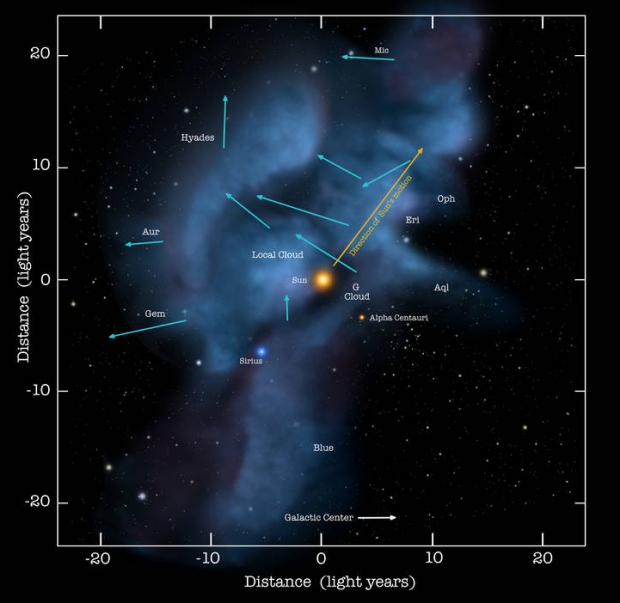
Image: Our solar journey through space is carrying us through a cluster of very-low-density interstellar clouds. Right now the Sun is inside of a cloud (Local cloud) that is so tenuous that the interstellar gas detected by the IBEX (Interstellar Boundary Explorer mission) is as sparse as a handful of air stretched over a column that is hundreds of light-years long. These clouds are identified by their motions, indicated in this graphic with blue arrows. Credit: NASA/Goddard/Adler/U. Chicago/Wesleyan.
The fate of Interstellar Probe is the hands of the National Academies of Sciences, Engineering, and Medicine, which prioritizes in its decadal studies where we are going in space exploration over ten year periods. We find out next year whether ISP has been selected among several strong candidates for the Decadal Survey for Solar and Space Physics (Heliophysics) 2024-2033. Until then, I continue to scout the literature both for Interstellar Probe as well as JPL’s Solar Gravitational Lens (SGL) mission, a candidate for the same study. These are huge decisions in space science.
Be aware of a new paper tackling the issues of heliospheric and dust science that a mission like Interstellar Probe could examine, with a solid backgrounder on the kind of instrumentation that would make this first dedicated interstellar probe a game-changer in our understanding of the local interstellar environment. The paper, by lead author Veerle J. Sterken (ETH Zürich) and colleagues, was originally submitted to the heliophysics Decadal, and is here available in a modified version (citation below) that includes the new instrumentation discussion among other modifications.
I won’t run through the entire paper; suffice it to say that its discussion of interstellar dust in and around the heliosphere is comprehensive and its analysis of how best to study changing environments in the interstellar medium is highly informative. The benefit of a probe explicitly designed to examine the transition between dust and gas states along its trajectory are clear. From the paper, which notes here the particular importance of heliopause passage:
ISP will fly throughout approximately 16 years, more than a solar cycle, while passing through interplanetary space, the termination shock, the heliosheath, up to the heliopause and beyond, making it an optimal mission for studying the heliosphere-dust coupling and using this knowledge for other astrospheres. Beyond the heliopause, the tiny dust with gyro-radii of only a few to 100 AU (for dust radii < 0.1 μm…), will help study the interstellar environment (magnetic field, plasma) and may detect local enhancements of smaller as well as bigger ISD [interstellar dust]. The strength of the mission lies in flying through all of these diverse regions with simultaneous magnetic field, dust, plasma and pickup ion measurements. No mission so far has flown a dedicated dust dynamics and composition suite into the heliosheath and the vast space beyond.
Analyzing the interaction between the heliosphere and interstellar dust acts as a probe into the history of our own Solar System, since we know that some of this material was affected by near-Earth supernovae, still raining down in the form of dust today. Mid-sized dust particles in the range of 0.1 to 0.6 μm in radius can make it through the heliosphere into the Solar System. Some smaller particles (30-100 nm) as well may escape filtering, but the authors note the limitations of our knowledge: “The exact lower cut-off size and time-dependence of particles that can enter the solar system is not yet exactly known, but Ulysses and Cassini already have measured ISD particles with radii between 50 and 100 nm.”
Thus we have markers for stellar and galactic evolution as factors in this study. But I’ll also remind those interested in interstellar flight that assessing dust density and the size distribution of particles will play a major role when we reach the point where we can send craft at a significant fraction of the speed of light. Larger particles in the local interstellar environment could cause catastrophic failure, while Ian Crawford has pointed out that other properties of this region could inform propulsion concepts like the interstellar ramjet.
Something else I learned from Ian Crawford (University of London) and wrote about twelve years ago (see Into the Interstellar Void) is that a spacecraft moving at 0.1c could make daily measurements 17 AU apart, which is roughly half the radius of the Solar System. So as we develop the fastest probe we can manage today in the form of designs like Interstellar Probe, we can see a larger picture in which such studies assist as we develop future technologies capable of actually making a crossing to Alpha Centauri, sampling widely along the way two different interstellar clouds and the boundary between them.
The paper is Sterken et al., “Synergies between interstellar dust and heliospheric science with an Interstellar Probe,” submitted as white paper for the National Academies Decadal Survey for Solar and Space Physics 2024-2033 and available as a preprint here.

Tidal Lock or Sporadic Rotation? New Questions re Proxima and TRAPPIST-1
Centauri Dreams regular Dave Moore just passed along a paper of considerable interest for those of us intrigued by planetary systems around red dwarf stars. The nearest known exoplanet of roughly Earth’s mass is Proxima Centauri b, adding emphasis to the question of whether planets in an M-dwarf’s habitable zone can indeed support life. From the standpoint of system dynamics, that often comes down to asking whether such a planet is not so close to its star that it will become tidally locked, and whether habitable climates could persist in those conditions. The topic remains controversial.
But there are wide variations between M-dwarf scenarios. We might compare what happens at TRAPPIST-1 to the situation around Proxima Centauri. We have an incomplete view of the Proxima system, there being no transits known, and while we have radial velocity evidence of a second and perhaps a third planet there, the situation is far from fully characterized. But TRAPPIST-1’s superb transit orientation means we see seven small, rocky worlds moving across the face of the star, and therein lies a tale.
The paper Dave sent, by Cody Shakespeare (University of Nevada Las Vegas) and colleague Jason Steffen, picks up on earlier work Shakespeare undertook that probes the differences between such scenarios. We know that conditions are right for a solitary planet, unperturbed by neighbors, to orbit with a spin rate synchronous with its orbital rate, the familiar ‘tidal lock.’ On such a world, we probe questions of climate, heat transport, the effects of an ocean and so on, to see if a planet with a star stationary in its sky could sustain life.
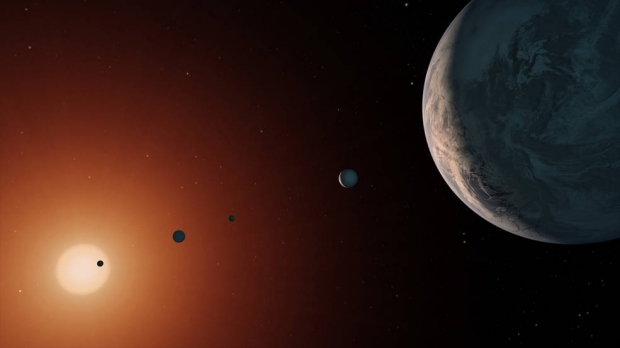
Image: This illustration shows what the TRAPPIST-1 system might look like from a vantage point near planet TRAPPIST-1f (at right). Credit: NASA/JPL-Caltech.
But as TRAPPIST-1 shows us in exhilarating detail, multi planet systems are not uncommon around this type of star, and now we have to factor in mean motion resonance (MMR), where the very proximity of the planets (all well within a fraction of Mercury’s orbit of our Sun) means that these effects can perturb a particular planet out of its otherwise spin-orbit synchronization. Call this ‘orbital forcing,’ which breaks what would have been, in a single-planet system, a system architecture that would inevitably lead to permanent tidal lock.
The results of this breakage produce the interesting possibility that planets like TRAPPIST-1 e and f may retain tidal lock but exhibit sporadic rotation (TLSR). Indeed, another recent paper referenced by the authors, written by Howard Chen (NASA GSFC) and colleagues, makes the case that this state can produce permanent snowball states in the outer regions of an M-dwarf planetary system. What is particularly striking about TLSR is the time frame that emerges from the calculations. Consider this, from the Shakespeare paper:
The TLSR spin state is unique in that the spin behavior is often not consistently tidally locked nor is it consistently rotating. Instead, the planet may suddenly switch between spin behaviors that have lasted for only a few years or up to hundreds of millennia. The spin behavior can occasionally be tidally locked with small or large librations in the longitude of the substellar point. The planet may flip between stable tidally locked positions by spinning 180°so that the previous substellar longitude is now located at the new antistellar point, and vice versa. The planet may also spin with respect to the star, having many consecutive full rotations. The spin direction can also change, causing prograde and retrograde spins.
Not exactly a quiescent tidal lock! Note the term libration, which refers to oscillations around the rotational axis of a planet. What Shakespeare and Steffen are analyzing is the space between long-lasting rotation and pure tidal lock. Indeed, the authors identify a spin scenario within the TLSR domain they describe as prolonged transient behavior, or PTB. Here the planet moves back and forth in a ‘spin regime’ that is essentially chaotic, so that questions of habitability become fraught indeed. Instead of a persistent climate, which we usually assume when assessing these matters, we may be looking at multiple states of climate determined by present and past spin regimes, and their necessary adaptation to the ever changing spin state.
Such global changes are reminiscent, though for different reasons, of Asimov’s fabled story “Nightfall,” in which scientists on a world in a system with six stars must face the social consequences of a ‘night’ that only appears every few thousand years. For here’s what Shakespeare and Steffen say about a scenario in which TSLR effects kick in, a world that had been tidally locked long enough for the climate to have become stable. The scenario again involves TRAPPIST-1:
Such a planet in the habitable zone around a TRAPPIST-1-like star could have an orbital period of around 4-12 Earth days – the approximate orbital periods of T-1d and T-1g, respectively. Due to the TLSR spin state, this planet may, rather abruptly, start to rotate, albeit slowly – on the order of one rotation every few Earth years. The previous night side of the planet, which had not seen starlight for many Earth years, will now suddenly be subjected to variable heat with a day-night cycle lasting a few years. The day side would receive a similar abrupt change and the climate state that prevailed for centuries would suddenly be a spinning engine with momentum but spark plugs that now fire out-of-sync with the pistons. In this analogy, the spark plugs and the subsequent ignition of fuel correspond to the input of energy from starlight. The response of ocean currents, prevailing winds, and weather patterns may be quite dramatic.
Not an easy outcome to model in terms of climate and habitability. The authors use a modified version of an energy release modeling software called 1D EBM HEXTOR as well as a model called the Hab1 TRAPPIST-1 Habitable Atmosphere Intercomparison (THAI) Protocol as they analyze these matters. I send you to the paper for the details.
Science fiction writers take note – here is rich material for new exoplanet environments. Notice that the TLSR spin state is different from the one-way change that occurs when a rotating planet gradually becomes tidally locked over large timescales. This is a regime of sudden change, or at least it can be. The authors consider spin regimes lasting less than 100 Earth years, with the longest regimes (these are classified as ‘quasi-stable’) lasting for 900 years or more and perhaps reaching durations of hundreds of thousands of years. The point is that “TLSR planets are able to be in both long-term persistent regimes and PTB regimes -– where frequent transitions between behaviors are present.”
We learn that all tidally locked bodies experience libration to some degree even if no other bodies are found in the system being examined. Four spin regimes are found within the broader spin state TLSR. Tidal lock with libration can occur around the substellar point, as well as around the substellar or antistellar point, or as noted a planet may be induced into a slow persistent rotation. Much depends upon how long any one of these ‘continuous’ states lasts; given enough time, a stable climate could develop. The chaotic behavior of the fourth state, prolonged transient behavior (PTB), induces frequent transitions in spin. Such transitions would be expected to produce extreme changes in climate.
The spin history of a given system will depend upon that system’s architecture and the key parameters of each individual planet, an indication of the complexity of the analysis. What particularly strikes me here is how fast some of these changes can occur. Here’s a science fiction scenario indeed:
The more extreme change is in the temperature of different longitudes as the planet transitions from a tidally locked regime to a Spinning regime or after the planet flips 180 and remains tidally locked. Rotating planets experience temperature changes at the equator of 50K or more over a single rotation period. The exact effects require more robust climate models, like 3D GCMs [Global Circulation Model], to properly examine. However, using comparisons with climate changes on Earth, it is likely that erosion of land masses would increase and major climate systems would experience significant changes.
As if the issue of habitability were not complex enough…
The paper is Shakespeare & Steffen, “Day and Night: Habitability of Tidally Locked Planets with Sporadic Rotation,” in process at Monthly Notices of the Royal Astronomical Society and available as a preprint. The Chen paper referenced above is “Sporadic Spin-Orbit Variations in Compact Multi-planet Systems and their Influence on Exoplanet Climate,” accepted at Astrophysical Journal Letters (preprint).

Getting Neptune into Focus
As a book-dazzled kid growing up in St. Louis, I had the good fortune to be surrounded by books from previous generations, and specifically those belonging both to my father and my half-brother, who had died long before I was born. Among these was a multi-volume encyclopedia from the 1920s I’ve never been able to identify. All I have is the memory of looking through its musty volumes and realizing that Pluto was not listed in it, as the publication date was a few years earlier than Clyde Tombaugh’s epic search for the world.

I do remember thinking that without Pluto, the Solar System only had eight planets, and musing in my teenage boy way about how odd this incomplete view of the Solar System was. Little did I know how much more was in store! As to that eighth planet, Neptune was a puzzler not only to the encyclopedia but to science fiction writers of the Gernsback era. Thus James Morgan Walsh’s “The Vanguard to Neptune,” published in Wonder Stories Quarterly in the Spring, 1932 issue. In the cover by Frank R. Paul, that’s Neptune hanging in the sky, looking for all the world like a terrestrial planet, here seen from Triton. The explorers assume the blue areas are ice until they cross to the planet.
Image: Frank R. Paul’s cover illustration for J. M. Walsh’s “The Vanguard to Neptune.” Walsh (1897-1952) was an interesting figure in his own right for those of us who spent a career living off the printed word. Settling in the UK, the Australian novelist would pen an astounding 94 novels across a wide range of genres and under a variety of pseudonyms. It was possible to do that kind of thing in the pulp era.
Spurring these recollections are images of Neptune revealed in a new study on the planet’s cloud cover and its relation to the solar cycle. They’re so stunning that I wanted to reproduce them here, thinking about how our knowledge of the Solar System has advanced since my first acquaintance with the planet in that encyclopedia as no more than a speck of light amongst countless others. There’s also a bit of the Voyager 2 thrill as the craft approached Neptune back in 1989 deep in the summer night here. To see new worlds open before us. Astonishing.
I suppose one day we’ll get so completely accustomed to imaging exoplanets that such thrills will seem commonplace, or maybe not, given their sheer diversity. But the images below still work for me, the first set from Hubble.
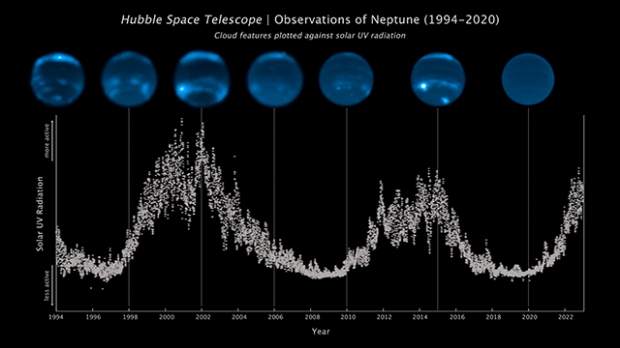
Image: This sequence of Hubble Space Telescope images chronicles the waxing and waning of the amount of cloud cover on Neptune. This nearly-30-year-long set of observations shows that the number of clouds grows increasingly following a peak in the solar cycle – where the Sun’s level of activity rhythmically rises and falls over an 11-year period. The Sun’s level of ultraviolet radiation is plotted in the vertical axis. The 11-year cycle is plotted along the bottom from 1994 to 2022. The Hubble observations along the top, clearly show a correlation between cloud abundance and solar peak of activity. The chemical changes are caused by photochemistry, which happens high in Neptune’s upper atmosphere and takes time to form clouds. Credit: NASA, ESA, LASP, Erandi Chavez (UC Berkeley), Imke de Pater (UC Berkeley).
I don’t mean to neglect the import of the paper that features these observations, which comes from astronomers at UC-Berkeley, or their conclusions, which use the numerous changes in the patterning of Neptune’s clouds to point to the connection with the flip in the Sun’s magnetic field every eleven years. It’s intriguing to learn that when the Sun emits more intense ultraviolet light, and in particular the strong hydrogen Lyman-alpha emission, there is increasing cloud cover on Neptune fully two years later.
Imke de Pater (UC-Berkeley) is senior author on the study:
“These remarkable data give us the strongest evidence yet that Neptune’s cloud cover correlates with the Sun’s cycle. Our findings support the theory that the Sun’s UV rays, when strong enough, may be triggering a photochemical reaction that produces Neptune’s clouds.”
We see 2.5 cycles of cloud activity on Neptune recorded over a 29-year period in observations not only from Hubble but Keck Observatory and Lick Observatory, in which it also becomes clear that there is a relationship between the number of clouds and the planet’s observed brightness. Below is the Keck imagery.
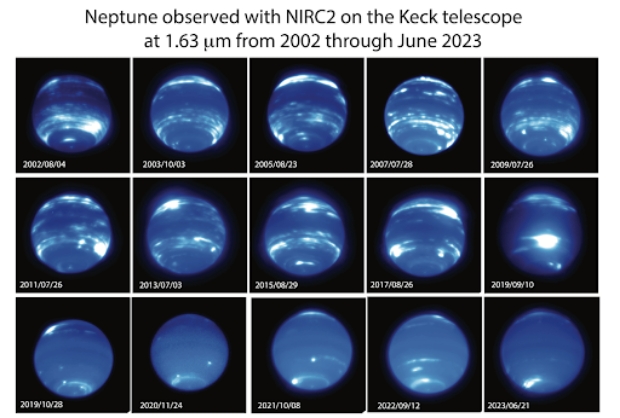
Image: A dramatic change in Neptune’s appearance was observed in late 2019 and has persisted through June 2023. As shown by this compilation of images at 1.63 µm (microns) obtained with the NIRC2 and adaptive optics system on the Keck II Telescope, Neptune had numerous cloud features organized in latitudinal bands from before 2002 through late 2019. Afterwards, clouds appeared almost absent except near the south pole. The images are displayed using a Asinh function which, like a log-scale display, decreases the contrast between the features; if displayed on a linear scale, only the brightest features would be visible. Credit: Imke de Pater, Erandi Chavez, Erin Redwing (UC Berkeley)/W. M. Keck Observatory.
This is tricky analysis, because as the paper points out, clouds not related to photochemical reactions, as for example those produced by storms rising up from the deep atmosphere, would complicate correlations with the solar cycle. More recent imagery from the summer of this year has begun to show more clouds in the northern latitudes and at high altitude, which de Pater says reflects the observed increase in the solar ultraviolet flux in the past two years. It’s chastening to realize that even with 30 years of high resolution data covering almost three solar cycles, we have still covered only 20 percent of Neptune’s orbit. Oh for an ice-giant orbiter to depict up close the chaotic actions on a planet whose winds are the strongest known in the Solar System.
The paper is Chavez et al., “Evolution of Neptune at near-infrared wavelengths from 1994 through 2022,” Icarus Vol. 404 (1 November 2023), 115667 (abstract).

LSST: Interstellar Interlopers and the Nature of Z
Interstellar studies toy with our expectations. Those of us who think about sending probes to other stars share the frustration of the long time-scales involved, not just in transit times but also in arriving at the technologies to make such missions happen. But the other half of interstellar studies, the observation and characterization of targets, is happening at a remarkable rate, with new instruments coming online and an entire class of extremely large telescopes in the pipeline. Exoplanet studies thrive.
In between, upcoming events are encouraging. Having identified two interstellar objects – 1I/ʻOumuamua and comet 2I/Borisov – in our own Solar System, we will shortly be able to expand the number of such confirmed interlopers enormously. That puts us in position to build intercept missions to study and sample material from another stellar system in relatively short order. The Legacy Survey of Space and Time (LSST), being planned for the now under construction Vera C. Rubin Observatory in Chile, should be able to detect interstellar materials passing through our system in abundance.
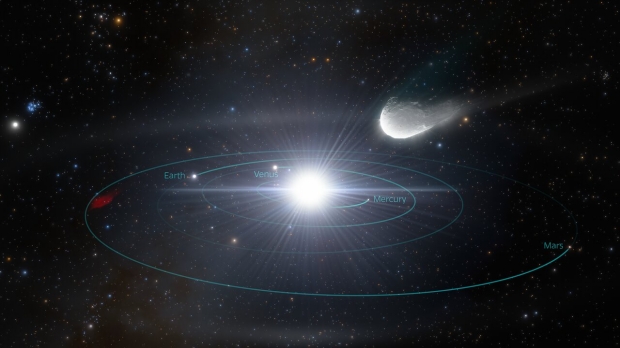
Image: An artist’s impression of a small, rocky interstellar object hurtling from the upper right toward the inner Solar System. The orbits of the four inner planets (Mercury, Venus, Earth, Mars) are fully visible, drawn as teal concentric circles around the bright ball of the Sun at the center. We see the orbits from a slightly elevated angle, so that the circular paths appear oval. The black background is sprinkled with points of starlight. The interstellar object looks like an elongated potato above the Sun, streaming toward the Sun from the upper right, with a short tail of gas and dust trailing behind. Credit: Rubin Observatory/NOIRLab/NSF/AURA/J. daSilva.
The LSST has crept into almost every discussion we’ve had in these pages about our two known interstellar visitors, along with the lament that had we found these objects sooner, we would have had been able to collect much more data from them. A 10-year survey of the southern sky (from the El Peñon peak of Cerro Pachón in northern Chile), the survey will use a large-aperture wide-field instrument called the Simonyi Survey Telescope (SST) to study half the sky every three nights in six optical bands. It will deploy the largest digital camera ever constructed, with a 9.6 square degree of view.
Using three refractive lenses, the LSST Camera will take a pair of 15-second exposures of each field, operating throughout the night. Astronomers plan over 5.2 million exposures in ten years, creating views that will be sensitive to redshifts up to z=3. Recall the terminology: z=3 means that the observed wavelength of light from a distant object is three times longer than the rest wavelength (when the light was emitted.
Because the z parameter represents the stretching of wavelength owing to the expansion of the universe, higher values of z represent more distant (and hence older) objects, receding from us at a significant percentage of the speed of light. I’ve seen a redshift of z=0.0043 for the galaxy M87, which is roughly 55 million light years from Earth. A redshift of z=3 implies an object whose light has been traveling 11 billion years to reach us. That would make the actual distance to the object today over 18 billion light years because of the continuing expansion of the universe as the light travels. Las Cumbres Observatory offers an excellent backgrounder on all this.
Forgive the digression – this is how I learn stuff. But the point is that what the LSST will create is what its planners call a ‘movie,’ one summing that decade of observation and exposures and sensitive to extraordinarily distant objects. To get a sense of this, consider that the LSST project will take 15 terabytes of data every night, yielding an uncompressed data set of 200 petabytes. And with this kind of sensitivity, interstellar objects moving into our own Solar System should appear with some regularity.
Michele Bannister (University of Canterbury, NZ), a member of the Rubin Observatory/LSST Solar System Science Collaboration, comments:
“Planetary systems are a place of change and growth, of sculpting and reshaping. And planets are like active correspondents in that they can move trillions of little tiny planetesimals out into galactic space. A rock from another solar system is a direct probe of how planetesimal formation took place at another star, so to actually have them come to us is pretty neat. We calculate that there are a whole lot of these little worlds in our Solar System right now. We just can’t find them yet because we aren’t seeing faint enough.”
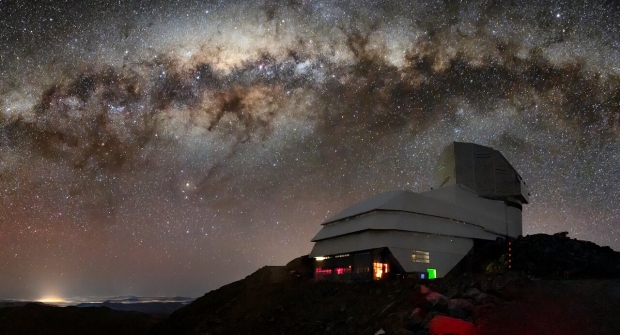
Image: This image captures not only Vera C. Rubin Observatory, a Program of NSF’s NOIRLab, but one of the celestial specimens Rubin Observatory will observe when it comes online: the Milky Way. The bright halo of gas and stars on the left side of the image highlights the very center of the Milky Way galaxy. The dark path that cuts through this center is known as the Great Rift, because it gives the appearance that the Milky Way has been split in half, right through its center and along its radial arms. In fact, the Great Rift is caused by a shroud of dust, which blocks and scatters visible light. This dust makes the Great Rift a difficult space to observe. Fortunately, Rubin is being built to conduct the Legacy Survey of Space and Time (LSST). This survey will observe the entire visible southern sky every few nights over the course of a decade, capturing about 1000 images of the sky every night and giving us a new view of our evolving Universe. Rubin Observatory is a joint initiative of the National Science Foundation and the Department of Energy (DOE). Once completed, Rubin will be operated jointly by NSF’s NOIRLab and DOE’s SLAC National Accelerator Laboratory to carry out the Legacy Survey of Space and Time. Credit: RubinObs/NOIRLab/NSF/AURA/B. Quint.
The LSST has uses far beyond interstellar interlopers, of course, with implications for the study of dark energy and dark matter as well as the formation of the Milky Way and the trajectories of potentially hazardous asteroids. But its emergence, beginning with first operations in late 2024, puts us on the cusp of studying planet formation using materials from other stellar systems. That brings intercept missions into the discussion, a topic we’ve considered in these pages before through the work of my friend Andreas Hein (University of Luxembourg). On a broader level, consider that expansion into the Solar System already has interstellar aspects, as I’ll discuss soon with a look at what we are learning about interstellar dust, and how missions beyond the heliosphere can inform our views of the local bubble in which we move.

Administrative Leave

“It seems that destiny has taken a hand.” Thus Humphrey Bogart, in a pivotal scene from the iconic 1942 film Casablanca. In Bogart’s case, destiny had to do with the sudden arrival of Claude Rains and the gendarmerie at Rick’s Café Américain, with profound implications for his relationship with Ilsa. In my case, fate was more jejune, involving the failure of my PC’s power supply just as I was asking myself whether it was now time for my August vacation. The power supply left little doubt. Surely a sign from the cosmos that after all the recent work reconfiguring the site’s software, I should take some time off?
That’s how I plan to interpret it, in any case. In the meantime, I’ll get the PC problem resolved. As to the still developing work on the site, a couple of things to note:
1) I am all too aware that the mobile experience is problematic, depending on what phone you use. I find this bewildering, as many people see the site correctly on their phones, whereas people like me see a very skinny column of text with huge side margins. So that is right up there on the list, and I plan to work on it during my time off. Since I can’t travel anywhere right now, I will be staying put. I will be on the site each day, moderating comments and also trying to work out glitches. But I will not be posting new material under my byline for approximately two weeks.
2) Speaking of glitches, this one came out of nowhere. I’ve learned that older posts have comment sections that are not formatting correctly. This too needs to be fixed, and part of my time off will be spent in the quest for answers on that matter.
Otherwise, in the next couple of weeks, I plan to watch old movies and read the novels now at the top of my fiction reading stack. These include books by Richard Ford, Alastair Reynolds, Graham Greene and Emily St. John Mandel, although I have to finish up Alan Furst’s wonderful The World at Night before proceeding to the first of these.
One last thing: Every now and then I get a message from someone who has had trouble trying to leave a comment with the new interface. Here’s the method: To comment, what you need to do is click on the title of the post, which will open the same post with the comment section in place at the end of the text.
As I say, keep the comments coming, as I’ll be here to put them through. Thanks to all for your patience and suggestions re the site changes. More to come.

